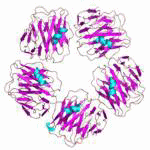Molecular Biology
|
18 september 2021 09:50:28 |
| IJMS, Vol. 22, Pages 10088: Pathogenesis and Molecular Mechanisms of Anderson–Fabry Disease and Possible New Molecular Addressed Therapeutic Strategies (International Journal of Molecular Sciences) |
|
Tweet Anderson–Fabry disease (AFD) is a rare disease with an incidenceof approximately 1:117,000 male births. Lysosomal accumulation of globotriaosylceramide (Gb3) is the element characterizing Fabry disease due to a hereditary deficiency α-galactosidase A (GLA) enzyme. The accumulation of Gb3 causes lysosomal dysfunction that compromises cell signaling pathways. Deposition of sphingolipids occurs in the autonomic nervous system, dorsal root ganglia, kidney epithelial cells, vascular system cells, and myocardial cells, resulting in organ failure. This manuscript will review the molecular pathogenetic pathways involved in Anderson–Fabry disease and in its organ damage. Some studies reported that inhibition of mitochondrial function and energy metabolism plays a significant role in AFD cardiomyopathy and in kidney disease of AFD patients. Furthermore, mitochondrial dysfunction has been reported as linked to the dysregulation of the autophagy–lysosomal pathway which inhibits the mechanistic target of rapamycin kinase (mTOR) mediated control of mitochondrial metabolism in AFD cells. Cerebrovascular complications due to AFD are caused by cerebral micro vessel stenosis. These are caused by wall thickening resulting from the intramural accumulation of glycolipids, luminal occlusion or thrombosis. Other pathogenetic mechanisms involved in organ damage linked to Gb3 accumulation are endocytosis and lysosomal degradation of endothelial calcium-activated intermediate-conductance potassium ion channel 3.1 (KCa3.1) via a clathrin-dependent process. This process represents a crucial event in endothelial dysfunction. Several studies have identified the deacylated form of Gb3, globotriaosylsphingosine (Lyso-Gb3), as the main catabolite that increases in plasma and urine in patients with AFD. The mean concentrations of Gb3 in all organs and plasma of Galactosidase A knockout mice were significantly higher than those of wild-type mice. The distributions of Gb3 isoforms vary from organ to organ. Various Gb3 isoforms were observed mainly in the kidneys, and kidney-specific Gb3 isoforms were hydroxylated. Furthermore, the action of Gb3 on the KCa3.1 channel suggests a possible contribution of this interaction to the Fabry disease process, as this channel is expressed in various cells, including endothelial cells, fibroblasts, smooth muscle cells in proliferation, microglia, and lymphocytes. These molecular pathways could be considered a potential therapeutic target to correct the enzyme in addition to the traditional enzyme replacement therapies (ERT) or drug chaperone therapy. |
| 180 viewsCategory: Biochemistry, Biophysics, Molecular Biology |
 IJMS, Vol. 22, Pages 10086: Serum Albumin: A Multifaced Enzyme (International Journal of Molecular Sciences) IJMS, Vol. 22, Pages 10086: Serum Albumin: A Multifaced Enzyme (International Journal of Molecular Sciences)IJMS, Vol. 22, Pages 10087: Enjoy Carefully: The Multifaceted Role of Vitamin E in Neuro-Nutrition (International Journal of Molecular Sciences) 
|
| blog comments powered by Disqus |
MyJournals.org
The latest issues of all your favorite science journals on one page
The latest issues of all your favorite science journals on one page



